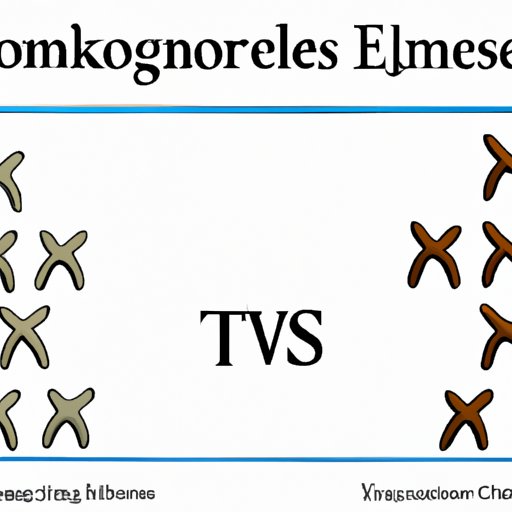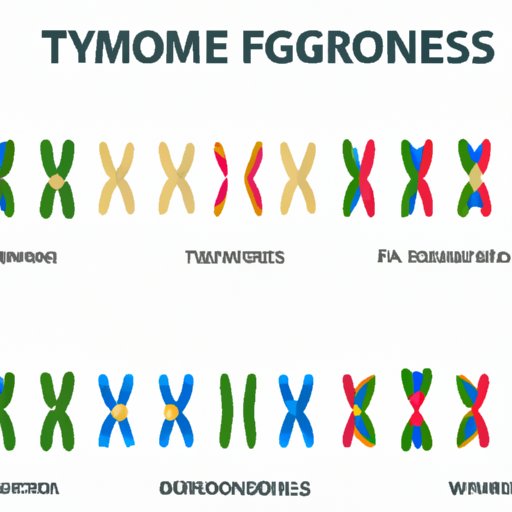Introduction
Homologous chromosomes have been one of the most important concepts in genetics research. It has helped scientists understand how cells divide, the role of homologous chromosomes in inheritance, and the patterns of evolution. This article provides a comprehensive guide to homologous chromosomes, including its structure, functions, relevance in genetics research, discoveries and theories, and its relationship to genetic disorders and inheritance.
The Ultimate Guide to Homologous Chromosomes: Understanding the Basics
In simple terms, homologous chromosomes are a pair of chromosomes that contain the same genes in the same order, but may have different alleles. Humans have 23 pairs of homologous chromosomes, making a total of 46 chromosomes in each cell. Homologous chromosomes have the same structure, consisting of two arms, a centromere, and telomeres at both ends.
A common mistake is to assume that homologous chromosomes are the same as sister chromatids. However, the main difference between the two is that sister chromatids are created when a chromosome replicates itself during the S-phase of interphase in the cell cycle. They are then separated during cell division, called mitosis. Homologous chromosomes, on the other hand, are only paired during meiosis I, the process of cell division that creates gametes, or sex cells.
Why Homologous Chromosomes are Important for Genetics Research
Homologous chromosomes play an important role in genetics research due to the impact they have on genetic variation. Since they contain the same genes, any differences in the alleles found on the chromosomes may result in variations of traits. This can contribute to the formation of new species or enhance the adaptability of existing species, leading to better chances of survival.
Research studies on homologous chromosomes have contributed to many significant findings in genetics. The structure of homologous chromosomes helped establish the chromosome theory of inheritance, which suggests that genes are located on chromosomes and are the physical basis of inheritance.
Breaking it Down: Homologous Chromosomes with Easy to Understand Examples
Let’s use the example of rolling dice to understand the concept of homologous chromosomes. Imagine a pair of dice, where each die has six sides, numbered one to six. Since there are two dice, there is a total of 36 possible combinations of numbers.
Now, let us say that each number on the dice represents a different gene. The numbers one through six appear on both dice, just like homologous chromosomes contain the same genes. However, the randomness of each roll of the dice results in different outcomes, just like the alleles on homologous chromosomes. This is why genetic variation exists, and why homologous chromosomes are important in genetics research and inheritance.
Exploring the Discoveries and Theories behind Homologous Chromosomes
Homologous chromosomes have been a topic of study for many years, and many discoveries have been made along the way. In fact, the study of homologous chromosomes helped to establish the chromosome theory of inheritance. This theory laid the foundation for modern genetics and suggested that genes were located on chromosomes and were the physical basis of inheritance.
Further studies related to homologous chromosomes have shown that organisms share similar genetic material. By examining homologous chromosomes in different species, scientists have identified common genes among them. This has led to the development of comparative genomics, a field that studies the relationship between organisms and how they have evolved over time.

How Homologous Chromosomes Affect Our Understanding of Evolution
Homologous chromosomes provide evidence that supports the theory of evolution. Comparative genomics, which compares the genetic material between organisms, helps to demonstrate the relationship and similarities between them. The more similar the homologous chromosomes between two different organisms, the more closely related they are.
For example, humans and chimpanzees have a very high degree of similarity in homologous chromosomes. This suggests a close evolutionary relationship between the two species. On the other hand, humans and bacteria are very dissimilar in their homologous chromosomes, reflecting a distant relationship.
The Role of Homologous Chromosomes in Identifying Genetic Disorders
Changes or abnormalities in homologous chromosomes are responsible for a variety of genetic disorders. By analyzing homologous chromosomes, scientists can identify these abnormalities, diagnose genetic disorders, and predict the likelihood of them being passed on to the next generation. Chromosomal disorders such as Down syndrome, Turner syndrome, and Klinefelter syndrome can all be identified through the examination of homologous chromosomes.
Homologous Chromosomes and Inheritance: A Comprehensive Overview for Beginners
Homologous chromosomes play a key role in the passing on of genetic traits from one generation to the next. This is because homologous chromosomes determine the genetic variation that exists in offspring. Genetic traits are expressed through a combination of alleles found on homologous chromosomes.
Some genetic disorders can also be associated with homologous chromosomes. For example, chromosomal disorders are caused by an abnormal number of homologous chromosomes or structural changes in them. Down syndrome occurs when an individual has an extra copy of chromosome 21. This results in differences in physical and intellectual development.
Conclusion
Homologous chromosomes are an integral part of genetics research. They provide essential information about genetic variation, heredity, and evolution. Understanding homologous chromosomes has led to breakthroughs in scientific research and medical diagnosis.
The study of homologous chromosomes is ongoing, and new discoveries about their significance continue to be made. By understanding the role that homologous chromosomes play in our genetic makeup, we can better understand our place in the world and the mysteries that exist within our own bodies.
